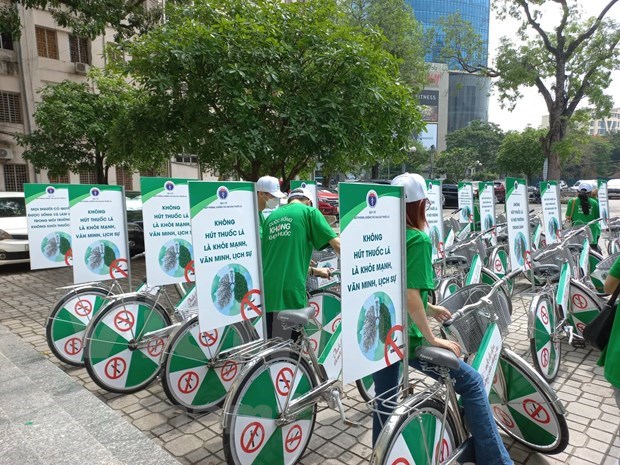
A drop has been reported in the number of male adult smokers, but the ratio of e-cigarette smokers among adolescents is rising in Vietnam, according to Associate Professor Dr. Luong Ngoc Khue, Director of the Ministry of Health's Department of Medical Examination and Treatment, and Director of the Vietnam Tobacco Control Fund (VNTCF).
A drop has been reported in the number of male adult smokers, but the ratio of e-cigarette smokers among adolescents is rising in Vietnam, according to Associate Professor Dr. Luong Ngoc Khue, Director of the Ministry of Health’s Department of Medical Examination and Treatment, and Director of the Vietnam Tobacco Control Fund (VNTCF).
Khue cited a survey on smoking among adults, which showed that the ratio of adult men who smoked decreased from 45.3 percent in 2015 to 42.3 percent in 2020.
The rate of passive smoking was also down significantly from 42.6 percent to 30.9 percent in the workplace, and from 59.9 percent to 56 percent during that time. The number of patients who successfully quit smoking from 2017 to 2020 was 1,111.
A survey conducted by the World Health Organisation (WHO) on student health behaviour in 2019 showed the smoking rate among students aged 13-17 decreased from 5.36 percent in 2013 to 2.78 percent in 2019, while the percentage of students who tried tobacco products decreased from 12.1 percent to 8.3 percent.
Public awareness of the harmful effects of tobacco also improved in the 2015-2020 period, with 96.2 percent of people believing smoking causes lung cancer, 81.1 percent saying smoking causes strokes, 77.8 percent believing smoking causes heart attacks, and 72.2 percent saying smoking causes all three diseases. Meanwhile, 65.2 percent of people have heard of the Law on Prevention of Tobacco Harms, said Khue, who held that this is an encouraging result to prevent and control the harmful effects of tobacco in Vietnam.
He said that currently, the VNTCF is supporting more than 100 agencies, including ministries, sectors, socio-political organisations, cities and provinces and hospitals to conduct activities related to the prevention and control of tobacco harms.
A report showed that in the 2019-2020 period, non-smoking regulations were implemented in 7,957 kindergartens, 7,846 primary schools, 4,606 secondary schools, 1,318 high schools, 202 universities and colleges, 598 provincial and district hospitals, 4,325 factories, 371 hotels and 513 restaurants.
However, Khue said there remain many challenges in the prevention and control of tobacco harms, including the increase of new tobacco products such as e-cigarettes and shisha.
According to the WHO, the ratio of e-cigarette smokers among adolescents was 2.6 percent in 2020.
The expert held that one of the major reasons behind the situation is inadequate tax on tobacco products. According to the Law on Special Consumption Tax, currently, the tax on cigarettes in Vietnam is 75 percent of the ex-factory price. If calculated on the retail price, this tax is only 36.1 percent, leading to low prices of cigarette products, making them easy to access, he said./.
 |
| Volunteers join a campaign calling on people to quit smoking (Photo: VNA) |
Khue cited a survey on smoking among adults, which showed that the ratio of adult men who smoked decreased from 45.3 percent in 2015 to 42.3 percent in 2020.
The rate of passive smoking was also down significantly from 42.6 percent to 30.9 percent in the workplace, and from 59.9 percent to 56 percent during that time. The number of patients who successfully quit smoking from 2017 to 2020 was 1,111.
A survey conducted by the World Health Organisation (WHO) on student health behaviour in 2019 showed the smoking rate among students aged 13-17 decreased from 5.36 percent in 2013 to 2.78 percent in 2019, while the percentage of students who tried tobacco products decreased from 12.1 percent to 8.3 percent.
Public awareness of the harmful effects of tobacco also improved in the 2015-2020 period, with 96.2 percent of people believing smoking causes lung cancer, 81.1 percent saying smoking causes strokes, 77.8 percent believing smoking causes heart attacks, and 72.2 percent saying smoking causes all three diseases. Meanwhile, 65.2 percent of people have heard of the Law on Prevention of Tobacco Harms, said Khue, who held that this is an encouraging result to prevent and control the harmful effects of tobacco in Vietnam.
He said that currently, the VNTCF is supporting more than 100 agencies, including ministries, sectors, socio-political organisations, cities and provinces and hospitals to conduct activities related to the prevention and control of tobacco harms.
A report showed that in the 2019-2020 period, non-smoking regulations were implemented in 7,957 kindergartens, 7,846 primary schools, 4,606 secondary schools, 1,318 high schools, 202 universities and colleges, 598 provincial and district hospitals, 4,325 factories, 371 hotels and 513 restaurants.
However, Khue said there remain many challenges in the prevention and control of tobacco harms, including the increase of new tobacco products such as e-cigarettes and shisha.
According to the WHO, the ratio of e-cigarette smokers among adolescents was 2.6 percent in 2020.
The expert held that one of the major reasons behind the situation is inadequate tax on tobacco products. According to the Law on Special Consumption Tax, currently, the tax on cigarettes in Vietnam is 75 percent of the ex-factory price. If calculated on the retail price, this tax is only 36.1 percent, leading to low prices of cigarette products, making them easy to access, he said./.
(Source:VNA)




